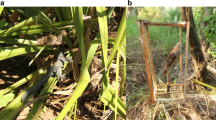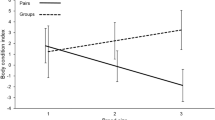Summary
The pied kingfisher has two types of helpers at the nest: primary ones, helping their own parents, and secondary ones, helping birds other than parents. Primary helpers are always accepted by breeding pairs, secondary helpers only in poor environmental conditions where the time and energy budget of parents is not sufficient for rearing the offspring alone. Under these conditions, helpers increase the breeding success of pairs (Tables 2 and 3) by providing additional food for the young (Table 4). Thus the flexible helper structure can be seen as an ecological adaptation. It is argued that-originating from a skewed sex ratio and breeding in colonies-this adaptation evolved through the combined effects of individual and kin selection.
Similar content being viewed by others
References
Backhurst, G.C.: East African ringing report 1972–1973. J. East Afr. Nat. Hist. Soc. Nat. Mus.146, 1–9 (1974)
Bischof, N.: Inzuchtbarrieren in Säugetiersozietäten. Homo23, 330–351 (1972)
Brosset, A.: Social organization and nest-building in the forest weaver birds of the genusMalimbus (Ploceinae). Ibis120, 27–37 (1978)
Brown, J.L.: Alternate routes to sociality in jays-with a theory for the evolution of altruism and communal breeding. Am. Zool.14, 63–80 (1974)
Brown, J.L.: The evolution of behaviour. New York Norton 1975
Brown, J.L.: Avian communal breeding systems. Annu. Rev. Ecol. Syst.9, 123–155 (1978)
Brown, J.L., Balda, R.P.: The relationship of habitat quality to group size in Hall's babbler (Pomatostomus halli). Condor79, 312–320 (1977)
Chipeta, G.B.: A study of wind power availability in Kenya, M.S. thesis, University of Nairobi (1976)
Douthwaite, R.J.: Some aspects of the biology of the lesser pied kingfisherCeryle rudis Linn. Ph.D. thesis, Makerere College, University of East Africa (1970)
Douthwaite, R.J.: Pied kingfisherCeryle rudis populations. Ostrich44, 89–94 (1973)
Douthwaite, R.J.: Fishing techniques and foods of the pied kingfisher on Lake Victoria in Uganda. Ostrich47, 153–160 (1976)
Douthwaite, R.J.: Breeding biology of the pied kingfisher on Lake Victoria. J. East Afr. Nat. Hist. Nat. Mus.31, 1–12 (1978)
Emlen, S.T.: The evolution of co-operative breeding in birds. In: Behavioural ecology. Krebs, J.R., Davies, N.B. (eds.), pp. 245–281. Oxford, London, Edinburgh: Blackwell 1978
Emlen, S.T.: Altruism, kinship, and reciprocity in the whitefronted bee-eater. In: Natural selection and social behaviour. Alexander, R.D., Tinkle, D. (eds.). New York: Chiron Press (in press) 1980
Fry, C.H.: The social organization of bee-eaters (Meropidae) and co-operative breeding in hot-climate birds. Ibis114, 1–14 (1972)
Fry, C.H.: The evolutionary significance of co-operative breeding in birds. In: Evolutionary ecology. Stonehouse, B., Perrins, C.M. (eds.), pp. 127–136. London: Macmillan 1977
Gaston, A.J., Perrins, C.: The relationship of habitat to group size in the genusTurdoides. Emu74 [Suppl.], 309 (1975)
Greenwood, P.J., Harvey, P.H., Perrins, C.M.: Inbreeding and dispersal in the great tit. Nature271, 52–54 (1978)
Grimes, L.G.: The occurrence of co-operative breeding in African birds. Ostrich47, 1–15 (1976)
Hamilton, W.D.: The genetical theory of social behaviour. I., II. J. Theor. Biol.7, 1–52 (1964)
Ligon, J.D., Ligon, S.H.: Communal breeding in green woodhoopoes as a case for reciprocity. Nature276, 296–298 (1978)
McClure, H.E.: Migration and survival of the birds of Asia. Bangkok 1974
Maynard Smith, J.: Group selection and kin selection. Nature201, 1145–1147 (1964)
Maynard Smith, J., Ridpath, M.G.: Wife sharing in the Tasmanian native hen,Tribonyx mortierii: A case of kin selection? Am. Nat.106, 447–452 (1972)
Migongo, E.W.K.: Environmental factors affecting the distribution of malachite and pied kingfishers in Lake Nakuru National Park. M.S. thesis, University of Nairobi (1978)
Parry, V.: The auxiliary social system and its effect on territory and breeding in kookaburras. Emu73, 81–100 (1973)
Pianka, E.R.: Evolutionary ecology. New York: Harper and Row (1978)
Ricklefs, R.E.: The evolution of co-operative breeding in birds. Ibis117, 531–534 (1975)
Rowley, I.: Co-operative breeding in Australian birds. Proc. XVI Int. Ornithol. Congr. (Canberra, Australia). Frith, H.J., Calaby, J.H. (eds.), pp. 657–666. Canberra: Australian Academy of Science 1976
Selander, R.K.: Speciation in wrens of the genusCampylorhynchus. Univ. Calif. Berkeley Publ. Zool.74, 1–224 (1964)
Skutch, A.F.: Helpers among birds. Condor63, 198–226 (1961)
Sugg, M.S.: Mensural and moult data from a breeding colony of pied kingfishers. Ostrich45, 227–234 (1974)
Vehrencamp, S.L.: The adaptive significance of communal nesting in groove-billed anisCrotophaga sulcirostris. Behav. Ecol. Sociobiol.4, 1–33 (1978)
Woolfenden, G.E.: Florida scrub jay helpers at the nest. Auk92, 1–15 (1975)
Woolfenden, G.E.: Co-operative breeding in American birds. Proc. XVI Int. Ornithol. Congr. (Canberra, Australia). Frith, H.J., Calaby, J.H. (eds.), pp. 674–684 Canberra: Australian Academy of Science 1976
Woolfenden, G.E.: Growth and survival of young Florida scrub jays. Wilson Bull.90, 1–18 (1978)
Woolfenden, G.E., Fitzpatrick, J.W.: The inheritance of territory in group-breeding birds. BioScience28, 104–108 (1978)
Zahavi, A.: Communal nesting by the Arabian babbler. Ibis116, 84–87 (1974)
Zahavi, A.: Co-operative nesting in Eurasian birds. Proc. XVI Int. Ornithol. Congr. (Canberra, Australia). Frith, H.J., Calaby, J.H. (eds.), pp. 685–693. Canberra: Australian Academy of Science 1976
Author information
Authors and Affiliations
Rights and permissions
About this article
Cite this article
Reyer, HU. Flexible helper structure as an ecological adaptation in the pied kingfisher (Ceryle rudis rudis L.). Behav Ecol Sociobiol 6, 219–227 (1980). https://doi.org/10.1007/BF00569203
Received:
Accepted:
Issue Date:
DOI: https://doi.org/10.1007/BF00569203




